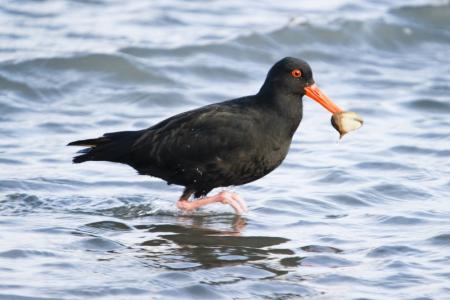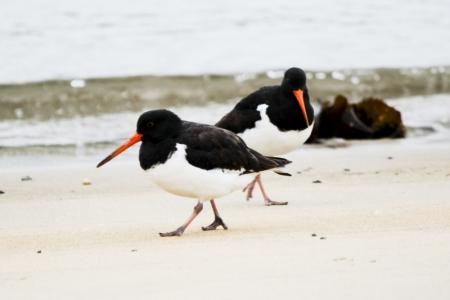|

There are two mainland species in New Zealand and both are seen on Pāuatahanui Inlet. The Variable Oystercatcher (seen here on the left) Toreapango (H. unicolor), is endemic. As its name suggests the plumage does vary, ranging from completely black (more common further south) to a pied phase with a white belly and white tinged wings. These colour variations are genetically determined and the frequency of the various phases varies widely between breeding colonies.
The South Island Pied Oystercatcher Torea, (H. finschi), seen below, is thought to be a sub-species of the Pied Oystercatcher found in Australia. The New Zealand variant is often abbreviated to SIPO. It can be distinguished from the pied phase of H. unicolor by a broad white bar on its wing and with the clearly defined white belly extending up to the lower neck region.

So, why the name 'oystercatcher'? Does it really catch oysters? Well - yes, possibly. The name was in fact originally coined in 1731 for the North American species, for which oysters are a common food source. The name then became the default for all species. Strangely, they were previously known as Sea Pie.
It is possible that our New Zealand species will eat oysters when opportunity permits, but not in the Pāuatahanui Inlet as we have none readily available. Oystercatchers are in fact carnivorous in the broad sense and feed on a variety of bivalve molluscs, crabs, worms. Bivalves are prised open using the long bill, or if that doesn't work, hammered open to extract the animal inside.
Both species are monogamous; after pairing they remain together all year long so you seldom see an oystercatcher completely alone on the shore. Their nests are shallow scrapings in sand or shingle but Pied Oystercatchers breed only in the South Island and records of the Variable Oystercatcher breeding in the Inlet are rare, though they do breed on Mana Island.
Photos on this page by kind permission of Helen Westerbeke.
|